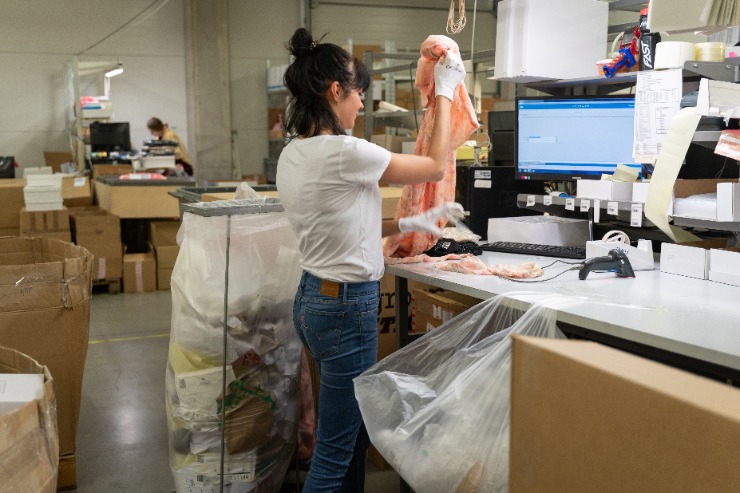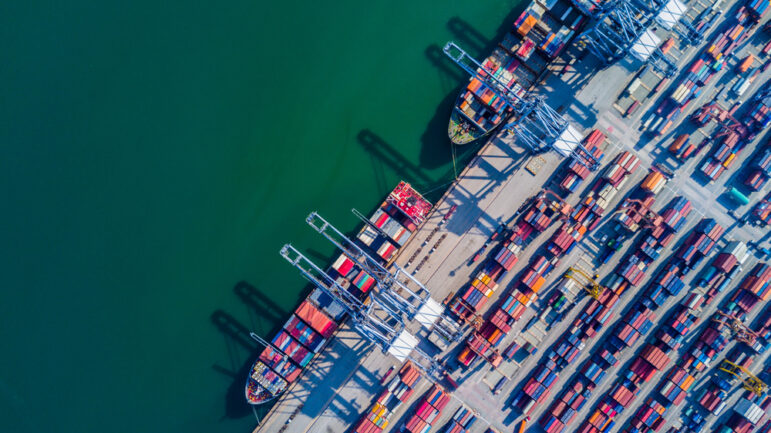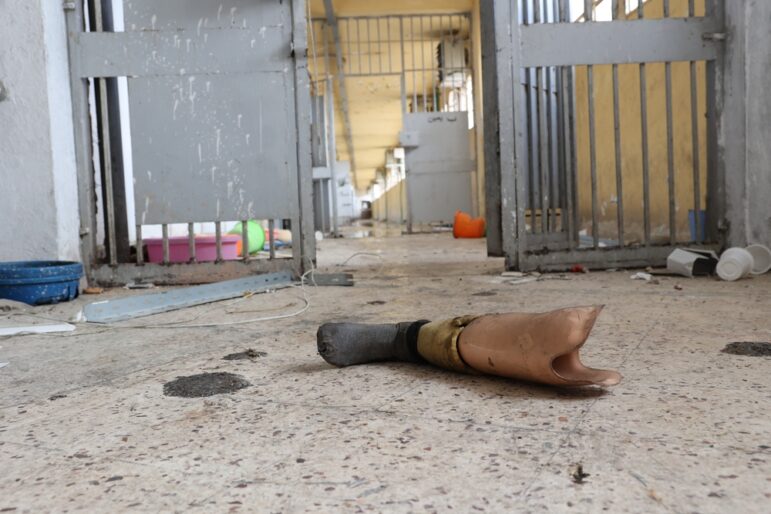

How They Did It: Using Trackers to Investigate Where Unwanted Clothing Ends Up
Read this article in

The fashion industry is changing, and the pivot to online clothes shopping has repercussions across the globe. Photo: Taisto Lapila, Yle
You have probably seen them: the clothing collection bins belonging to charities or fashion chains where you can dump your used jeans or T-shirts. It might ease your guilt about buying another item of clothing that you don’t really need, since your old item is going to a good cause, right? But what really happens to those used garments? Where do they travel? Are they sold and to whom? And what happens to the most ragged clothes?
Or perhaps this story can begin even earlier, in the clothes you order online. Browse through a number of different sites and, in Finland at least, you can order several dresses and return those that don’t fit. Many stores even encourage shoppers to do this: they tell you that your home is your fitting room. But what happens to the clothing you return? Is it repackaged and resold, or dumped?
We started to investigate these stories last year, and our methodologies followed a similar path. Here, we’ll look at each investigation in turn to find out what we discovered, how we went about investigating this subject, and our tips on using trackers like the ones we used — tiny devices that can emit signals allowing reporters to follow an item for up to a year — in your own investigations.
Exporting Unwanted Clothing Overseas
by Minna Knus-Galán
It didn’t take us long to find out that the multi-billion-dollar business of used clothing is surprisingly secretive. The experts we spoke to about this trade knew that most of the textiles donated by consumers in countries like Finland are sold abroad, but not even the experts or the organizations that collect the garments know their final destination.
We spoke to the biggest charity organization in Finland and the big sorting centers in Europe, but they didn’t let our cameras into their facilities: No interviews, no filming allowed. It got me wondering, why on earth is the business centered around my old T-shirt so secretive? That’s when we got the idea of using GPS tracking tags.
I had seen trackers being used in journalistic projects about electronic waste, but not in relation to clothing. We needed the smallest possible trackers with long-lasting batteries and global coverage, since we didn’t know how long the garments would travel, and to where.
I didn’t know how to source these, and when I contacted colleagues experienced in researching stories by using devices, I came to a dead-end: all the devices they recommended were too big and heavy for us to hide in clothing.
But in the autumn of 2019 I heard of a project my colleagues at Yle, the Finnish Broadcasting Company, had done to follow plastic waste via small trackers. They had bought them from a small Finnish company. I called, and bingo! They had just received a set of new devices that would be perfect for our needs: small devices that combined GPS trackers, which use satellite technology, and GSM trackers, a wireless transmission system that connects cell phones. These work with a sim card and are normally used on dogs or to help people with Alzheimer’s disease. You can follow the trackers’ progress with an app on your smartphone.
So that winter, we hid six small trackers in several items: a pair of my husband’s jeans that had a broken zipper, my daughter’s stained sweater, a jacket full of cigarette holes and covered in oil stains, and a green hoodie with broken seams, plus two other pieces of clothing. They were in quite bad condition. Then we put the garments into charity collection bins and the drop-off boxes where high street fashion chains collect used and unwanted clothes.
The charities we spoke to say that they don’t export clothes that are in a bad shape. One of the organizations told us they don’t export used garments to Africa. But our trackers told another story. All six garments were apparently sent out of Finland. The jeans went to a huge sorting center in Germany, a winter coat ended up in Latvia, a men’s jacket traveled to Helsinki harbor where we lost the signal. As for the other three, after five months we got a signal from Nigeria from the ragged hoodie, after six months the stained sweater arrived in Kenya, and after a year the biggest surprise: the jacket with holes and oil stains had arrived in Pakistan.
We were amazed that the batteries of the trackers would last six months, let alone a year. But we learned a few things along the way, and here are our tips:
- For longevity, use GSM, the mobile tracker, instead of GPS, which uses satellite data. For us, it was more important to have the tracker last as long as possible, this was more important than the kind of precise location information you get with GPS.
- Change the settings so that you get signals and alerts less frequently, especially if you are monitoring something that will take some time. That will help the battery last longer.
- Where possible, avoid exposing your trackers to the cold, which empties the battery faster. We minimized this by wrapping the trackers in fabric and sewing them inside the pockets and seams.
- If you can, use several trackers per item in case some stop working. One of our trackers sent its last signal in Helsinki harbor a few miles from where we started: if we’d had a backup option, the trail might not have gone cold.
We broadcast our findings with our national public service broadcaster, Yle, in two documentaries (one in 2020 and another in 2021, both with English subtitles) and published several written stories about the global trade in used garments.
What did our investigation reveal? Three of our garments in bad shape ended up outside Europe, even though the charities told us they wouldn’t. Also, the chain of middlemen is long and not even Finnish charities know where their European partners sell the clothes.
Our stained and torn sweaters ended up in Africa. We can’t know for sure what exactly happened to them once they got there, but typically second-hand clothes travel from Europe in bales to Africa where sellers, mostly women, buy them without knowing the quality of the clothes. The best clothes are sold at huge second-hand street markets, the poorer quality items are thrown away.
Based on Finnish export and import data, we knew Mozambique is one of the countries where Finland exports used textiles, so we decided to film there.
These second-hand clothes are often called “dead white man’s clothes,” and while selling them at market is important for these people’s livelihoods, nobody is going to buy ragged clothes. The sellers told us that the quality of the clothes they are buying in these bundles is getting worse.

A market in Mozambique where second hand clothing, colloquially known as “dead white man’s clothes,” is sold. Photo: Hanna Nordenswan, Yle
You might argue that selling usable clothes to Africa is part of a sustainable circular economy. But the idea of shipping stained, ragged garments from Europe or the United States to Africa is in no way ethical.
According to Oxfam, more than 70% of the clothes donated globally end up in Africa. In many African countries, the second-hand Western clothes market has been criticized for destroying the local textile industry and some countries have even banned the importation of used garments.
Our findings showed that rich countries are dumping their waste problem onto the African continent — even if the charities promise otherwise. With cheap fashion flooding the world, textile waste becomes a huge global problem. Finns throw away approximately 70 million kilograms of textiles a year, enough to fill 800 swimming pools. And that’s just Finland — each year.
We wanted our investigation to show the impact of fast, or cheap, fashion on the other end of the supply chain. Clothes that often come from factories in Asia with poor working conditions, travel to the West, where low prices often make such items “disposable,” and when they’re no longer wanted, they travel again, around the globe – this time as used garments or waste.
Scientists we interviewed calculated the carbon footprint for the used clothes Finland exports in a year as equivalent to 12,000 people flying from Finland to London. The implications of such a massive carbon footprint come at a time when the fashion industry is already facing a reckoning on carbon emissions, dyes and toxins, and water use.
We need to investigate the fashion industry through the entire supply chain: not only the starting point where the clothes are produced, but also the endpoint to see what really happens to our used clothes. We also need more transparency from the industry so that consumers can see the whole picture and the consequences of buying fast fashion.
Popping a bag of old clothes in the charity box is not the end of the story — even if it makes us feel better — but is in fact the start of a new journey, often to the other side of the world.
What Happens When You Send New Clothes Back?
by Jessica Stolzmann
Online shopping has exploded during the pandemic. In many countries, where shops were closed or people were advised to stay at home to contain rising infection rates, online retail offered a way for shops to keep revenues rolling in.
But even before the pandemic, the shift to purchasing online led to a big increase in returned goods. On average, every third item ordered online in Finland is sent back to the stores, according to statistics from the main Finnish postal firm. When it comes to fast fashion — clothing that is made quickly and provided cheaply to consumers — some believe the figure could be even higher, almost every other item.
Inspired by a similar investigation by the Swedish site Breakit, I decided to investigate what happens to clothes that are bought online and returned. I bought the same trackers, but since I knew the clothes I was looking at would travel fast, I used satellite data from the tracker’s GPS instead of GSM information. I wanted the trackers to report back to me every other hour in order to determine the exact route these “unwanted” clothes were taking.
I bought five items from the most popular online clothing stores and sent each back with a tracker. Within a few days, almost all our trackers had reached different warehouses in Sweden.
But there was no answer yet about what had happened to the clothes. Were they sold again, or were they destroyed? The companies had reassured me that cases where the clothes cannot be sold again are very rare, but I wanted to find out.
Unfortunately, some of the trackers were manually deactivated, while others ran out of battery at the warehouse. I had opted for an open investigation, which meant that the trackers were not hidden. Each one came with a message to the finder, and my e-mail address so they could contact me.
If we had found smaller trackers with better batteries maybe we could have tracked them longer. But to avoid possibly violating consumer privacy, we didn’t want to end up tracking a customer if the clothes were sold again.
Each returned item with a tracker came bundled with a message in hope the finder would contact us. Photo: Taisto Lapila, Yle
But then we got lucky. One of the trackers caught my interest: it had ended up near the Estonian capital, Tallinn. The GPS gave me the exact location of this piece of clothing so I traveled to Tallinn where I found a company specializing in so-called “return management,” a growing business in countries like Estonia and Poland.
I found out the company unpacked and checked clothing returns, for instance removing hair and lint from them, with the aim of getting them in perfect condition so that they could be sold again. According to the manager, who we interviewed, many of the clothes they receive have been used by customers — they can tell from the smell or stains on the clothing.
But what I discovered in Tallinn, from talking to the women restoring the clothes and their manager, is that items worth less than €60 ($70 USD) are not considered worth salvaging. So instead they are sold or donated to a different company or a charity. These companies or charities then either destroy them or sell them outside Europe.
One of the charities receiving these clothes is the Salvation Army. Traveling back from Estonia, I visited one of the charity’s warehouses in Turku, in the southwest of Finland, a few hundred kilometers across the Baltic Sea from Tallinn.
The depot there was filled with boxes with returned clothes that were all on their way to Irbil in northern Iraq: just some of the many tons of returned clothing shipped out of Europe every year.
Because of the pandemic, I couldn’t travel to Iraq, so I got in contact with a cameraman in Irbil who found clothes that were shipped from Finland by the Salvation Army. The charity first sells the clothes to a local company, which then resells them to buyers of local shops named Oslo and Stockholm. There, the clothes are then sold together with items that are out of season or that were unsold in previous fashion cycles. The shop owners told us only some of the clothes are worth selling, and that the rest end up in a landfill site outside Irbil.

This is where returned clothes from Europe might ultimately end up — in a landfill in Iraq. Photo: Hawkar Ahmed, Yle
What did we find out with this investigation? We published both a web story and a documentary on our findings, which showed how some of the clothes we buy online and send back — even those that might be in perfect condition and unused — risk ending up in a landfill on another continent. The economics of returning an item to a store or a new consumer make it unprofitable for many companies. We know that an enormous and complex logistics chain has been built around this.
We also discovered that no one seems to take responsibility when the clothes travel outside Europe: The clothes travel from middleman to middleman, and no one seems to know the final destination. In fact, for competitive reasons, many clothing companies oblige the charities or companies they work with to take the clothes outside their own market. But of course, that adds to the mileage — and carbon footprint — of that unwanted swimsuit or too-small pair of jeans.
We also learned a number of things about using tracking tags in the course of this project. The main issue was finding trackers small enough, but that still had a good quality battery. The trackers we used weren’t optimal, and we couldn’t track a specific item all the way to the landfill in Iraq.

Many of the returned clothes smell or have stains and can not be sold again. Photo: Taisto Lapila, Yle
However, the trackers did help us find the route of one of the items I returned, and from there, the winding route of some of Finland’s returned clothes. That in turn helped us calculate the carbon footprint, and also pointed towards us to the extensive logistics network that takes care of unwanted garments.
We were able to calculate the carbon footprint of the returns by working with a scientist at the Finnish Environment Institute. This figure was calculated using what is called a life cycle assessment approach: this gives a value for transport-related emissions based on the distance an item travels by land or by sea, its weight, and multiplying this by the average emissions for those transport methods.
The sobering conclusion: When you add up the carbon footprint of all the returns in Europe over the course of one year, they are equivalent to a major city during the same period of time.
Even more troubling, most of these returns are unnecessary. And if people knew what might happen to the returned clothes and the corresponding environmental cost, I believe they would probably behave quite differently. At least I would think twice before using my home as a fitting room, to avoid creating more trash on the other side of the world.
Editor’s note: Both writers are speaking at the Global Investigative Journalism Conference about their work investigating clothing supply chains. You can sign up to attend the online conference, which takes place November 1-5, here.
Additional Resources
GIJN Resource Center: Investigating Supply Chains
Using a Mobile Phone Survey to Investigate South Sudan’s Conflict
My Favorite Tools with Pulitzer-Winning Reporter Martha Mendoza
 Minna Knus-Galán is a reporter on the investigative team MOT at the Finnish Broadcasting Company, Yle. Knus-Galán’s coverage of money laundering, Bangladesh garment factories, and corruption have earned several awards. She has participated in multiple cross-border projects and is author of the book “Projekt Panama” on the Pulitzer Prize-winning Panama Papers.
Minna Knus-Galán is a reporter on the investigative team MOT at the Finnish Broadcasting Company, Yle. Knus-Galán’s coverage of money laundering, Bangladesh garment factories, and corruption have earned several awards. She has participated in multiple cross-border projects and is author of the book “Projekt Panama” on the Pulitzer Prize-winning Panama Papers.
 Jessica Stolzmann is an award-winning investigative journalist in the Swedish-speaking section of Yle, the Finnish Broadcasting Company. She previously worked as a foreign news reporter. A few years ago she shifted to investigative journalism, covering topics such as transgender issues, working conditions, and land conflicts in Brazil.
Jessica Stolzmann is an award-winning investigative journalist in the Swedish-speaking section of Yle, the Finnish Broadcasting Company. She previously worked as a foreign news reporter. A few years ago she shifted to investigative journalism, covering topics such as transgender issues, working conditions, and land conflicts in Brazil.









